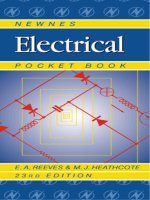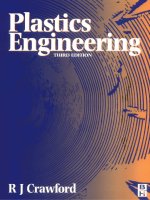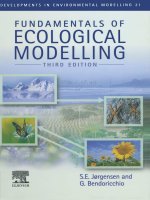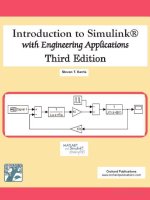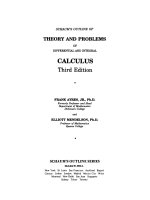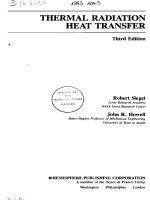ENGINEE RING STUDENTS THIRD EDITION tor-T.H.G. MEGSON pptx
Bạn đang xem bản rút gọn của tài liệu. Xem và tải ngay bản đầy đủ của tài liệu tại đây (26.05 MB, 610 trang )
-
tor
E
N
G
I
N
E
E
RrN
G
STU
D
E
NTS
THIRD
EDITION
T.H.G.
MEGSON
Aircraft Structures
for engineering students
To
The
Memory
of
My
Father
Aircraft Structures
for engineering students
Third Edition
T.
H.
G.
Megson
i
EINEMANN
OXFORD
AMSTERDAM
BOSTON
LONDON NEWYORK PARIS
SANDIEGO
SANFRANCISCO
SINGAPORE
SYDNEY TOKYO
Butterworth-Heinemann
An imprint of Elsevier Science
Linacre House, Jordan Hill, Oxford OX2 8DP
200 Wheeler Road, Burlington,
MA
01803
First published by Arnold 1972
First published
as
paperback 1977
Second edition published by Arnold 1990
Third edition published by Arnold 1999
Reprinted by Butterworth-Heinemann 2001 (twice), 2002,2003
Copyright
Q
1999, T H
G
Megson. All rights reserved.
The right of T H
G
Megson to be identified
as
the authors of this work
has been asserted
in
accordance with the Copyright, Designs and
Patents Act 1988
No part of this publication may be reproduced in any material form
(including photocopying or storing in any medium by electronic means
and whether or not transiently or incidentally to some other use of this
publication) without the written permission
of
the copyright holder except
in accordance with the provisions of the Copyright, Designs and Patents Act
1988 or under the terms of a licence issued by the Copyright Licensing
Agency Ltd, 90 Tottenham Court Road, London, England
WIT
4LP.
Applications for the copyright holder’s written permission to reproduce any
part of this publication should be addressed to the publishers.
Permissions may be sought directly from Elsevier’s Science and Technology
Rights Department in
Oxfod,
UK:
phone:
(+44)
(0)
1865 843830;
fax:
(+44)
(0)
1865 853333; email:
You
may also complete your request on-line via the Elsevier Science
homepage
(),
by selecting ‘Customer Support’
and then ‘Obtaining Permissions’.
British Library
Cataloguing
in
Publication
Data
A catalogue record for this book is available from the British Library
Library
of
Congress
Cataloging in
Publication
Data
A catalogue record for
this
book is available from the Library of Congress
ISBN
0
340 70588 4
For
information
on
all
Butterworth-Heinemann publications
please visit
our
website at www.bh.com
Typeset in 10112 Times by Academic
&
Technical vpesetting, Bristol
Printed and bound in Great Britain by
MPG
Books Ltd, Bodmin, Cornwall
Contents
Preface
Preface
to
Second
Edition
Preface
to
Third
Edition
Part
I
Elasticity
1 Basic elasticity
1.1 Stress
1.2
1.3 Equations of equilibrium
1.4 Plane stress
1.5 Boundary conditions
1.6
1.7 Principal stresses
1.8 Mohr’s circle
of
stress
1.9
Strain
1.10 Compatibility equations
1.11 Plane strain
1.12 Determination of strains on inclined planes
1.13 Principal strains
1.14 Mohr’s circle
of
strain
1.15 Stress-strain relationships
1.16 Experimental measurement
of
surface strains
Notation for forces and stresses
Determination of stresses on inclined planes
References
Problems
2
Two-dimensional problems in elasticity
2.1 Two-dimensional problems
2.2
Stress functions
2.3
Inverse and semi-inverse methods
2.4 St. Venant’s principle
2.5
Displacements
2.6
Bending
of
an end-loaded cantilever
ix
xi
Xlll
1
3
3
5
7
8
9
10
11
12
16
19
20
21
23
23
24
28
32
32
36
37
38
39
42
43
43
vi
Contents
Reference
Problems
48
48
3
Torsion of solid sections
3.1
Prandtl stress function solution
3.2
3.3
The membrane analogy
3.4
St. Venant warping function solution
Torsion
of
a narrow rectangular strip
References
Problems
4
Energy methods of structural analysis
4.1
4.2
Total potential energy
4.3
Principle of virtual work
4.4
4.5
4.6
Application to deflection problems
4.7
4.8
Unit load method
4.9
Principle of superposition
4.10
The reciprocal theorem
4.11
Temperature effects
Strain energy and complementary energy
The principle of the stationary value of the total potential energy
The principle of the stationary value of the total complementary
energy
Application to the solution of statically indetenninate systems
References
Further reading
Problems
5
Bending of thin plates
5.1
5.2
5.3
5.4
5.5
5.6
Pure bending of thin plates
Plates subjected to bending and twisting
Plates subjected to a distributed transverse load
Combined bending and in-plane loading of a thin rectangular plate
Bending of thin plates having a small initial curvature
Energy method for the bending of thin plates
Further reading
Problems
6
Structural instability
6.1
Euler buckling of columns
6.2
Inelastic buckling
6.3
Effect of initial imperfections
6.4
6.5
6.6
Buckling of thin plates
6.7
Inelastic buckling of plates
6.8
Stability of beams under transverse and axial loads
Energy method for the calculation
of
buckling loads in columns
Experimental determination
of
critical load for a flat plate
51
51
59
61
63
65
65
68
68
70
71
73
76
77
85
100
103
103
107
109
110
110
122
122
125
129
137
141
142
149
149
152
152
156
160
162
165
169
173
174
6.9 Local instability
6.10 Instability of stiffened panels
6.11 Failure stress in plates and stiffened panels
6.12 Flexural-torsional buckling of thin-walled columns
6.13 Tension field beams
References
Problems
Part
I1
Aircraft
Structures
7 Principles of stressed skin construction
7.1 Materials of aircraft construction
7.2 Loads on structural components
7.3 Function of structural components
7.4 Fabrication
of
structural components
Problems
8 Airworthiness and airframe loads
8.1
8.2 Load factor determination
8.3 Aircraft inertia loads
8.4
Symmetric manoeuvre loads
8.5
8.6 Gust loads
8.7 Fatigue
References
Further reading
Problems
Factors of safety
-
flight envelope
Normal accelerations associated with various types
of
manoeuvre
9 Bending, shear and torsion of open and closed, thin-walled beams
9.1
9.2
9.3
9.4
9.5
9.6
9.7
9.8 Structural idealization
9.9
9.10 Deflection
of
open and closed section beams
Bending of open and closed section beams
General stress, strain and displacement relationships for open and
single cell closed section thin-walled beams
Shear
of
open section beams
Shear
of
closed section beams
Torsion
of
closed section beams
Torsion of open section beams
Analysis of combined open and closed sections
Effect
of
idealization
on
the analysis
of
open and closed
section beams
Problems
10 Stress analysis of aircraft components
10.1 Tapered beams
10.2 Fuselages
Contents
vii
174
175
i77
180
188
197
197
209
211
21 1
220
223
225
232
233
233
235
238
244
248
25 1
257
27
1
272
272
276
276
29
1
295
300
307
316
322
327
331
342
345
362
3
62
3 74
viii
Contents
10.3 Wings
10.4 Fuselage frames and wing ribs
10.5 Cut-outs in wings and fuselages
10.6 Laminated composite structures
Reference
Further reading
Problems
11 Structural constraint
1 1.1 General aspects of structural constraint
11.2 Shear stress distribution at a built-in end of a closed section beam
1 1.3 Thin-walled rectangular section beam subjected to torsion
11.4 Shear lag
11.5 Constraint of open section beams
References
Problems
12 Matrix methods of structural analysis
12.1 Notation
12.2 Stiffness matrix for an elastic spring
12.3 Stiffness matrix for two elastic springs in line
12.4 Matrix analysis
of
pin-jointed frameworks
12.5 Application to statically indeterminate frameworks
12.6 Matrix analysis of space frames
12.7 Stiffness matrix for a uniform beam
12.8 Finite element method for continuum structures
References
Further reading
Problems
13 Elementary aeroelasticity
13.1 Load distribution and divergence
13.2 Control effectiveness and reversal
13.3 Structural vibration
13.4 Introduction to ‘flutter’
References
Problems
380
406
415
425
432
432
432
443
443
445
449
455
465
485
486
494
495
496
497
500
507
507
509
516
533
533
533
540
54 1
546
55
1
568
576
577
Index
582
Preface
During my experience of teaching aircraft structures
I
have felt the need for a text-
book written specifically for students of aeronautical engineering. Although there
have been a number of excellent books written on the subject they are now either
out of date or too specialist in content to fulfil the requirements of an undergraduate
textbook. My
aim,
therefore, has been to fill this gap and provide a completely self-
contained course in aircraft structures which contains not only the fundamentals of
elasticity and aircraft structural analysis but also the associated topics of airworthi-
ness and aeroelasticity.
The book is intended for students studying for degrees, Higher National Diplomas
and Higher National Certificates in aeronautical engineering and will be found of
value to those students in related courses who specialize in structures. The subject
matter has been chosen to provide the student with a textbook which will take him
from the beginning of the second year of his course, when specialization usually
begins, up to and including
his
final examination.
I
have arranged the topics
so
that they may be studied to an appropriate level in, say, the second year and then
resumed at a more advanced stage in the final year; for example, the instability of
columns and beams may be studied as examples of structural instability at second
year level while the instability of plates and stiffened panels could be studied in the
final year. In addition,
I
have grouped some subjects under unifying headings to
emphasize their interrelationship; thus, bending, shear and torsion of open and
closed tubes are treated in a single chapter to underline the fact that they are just
different loading cases of basic structural components rather than isolated topics. I
realize however that the modern trend is to present methods of analysis in general
terms and then consider specific applications. Nevertheless,
I
feel that in cases
such as those described above it is beneficial for the student’s understanding of the
subject to see the close relationships and similarities amongst the different portions
of theory.
Part
I
of the
book,
‘Fundamentals of Elasticity’, Chapters
1-6,
includes sufficient
elasticity theory to provide the student with the basic tools of structural analysis.
The work is standard but the presentation in some instances is original.
In
Chapter
4
I
have endeavoured to clarify the use of energy methods of analysis and present a
consistent, but general, approach to the various types
of
structural problem
for
which energy methods are employed. Thus, although a variety of methods are dis-
cussed, emphasis is placed on the methods of complementary and potential energy.
x
Preface
Overall, my intention has been to give some indication of the role and limitations of
each method of analysis.
Part
11,
‘Analysis of Aircraft Structures’, Chapters
7-1
1
,
contains the analysis
of
the
thin-walled, cellular type of structure peculiar to aircraft.
In
addition, Chapter
7
includes a discussion of structural materials, the fabrication and function of structural
components and an introduction to structural idealization. Chapter
10
discusses the
limitations of the theory presented in Chapters
8
and
9
and investigates modifications
necessary to account for axial constraint effects. An introduction to computational
methods of structural analysis is presented in Chapter
11
which also includes some
elementary work on the relatively modern finite element method for continuum
structures.
Finally, Part
111,
‘Airworthiness and Aeroelasticity’, Chapters
12
and
13,
are self
explanatory.
Worked examples are used extensively in the text to illustrate the theory while
numerous unworked problems with answers are listed at the end of each chapter;
S.I.
units are used throughout.
I
am indebted to the Universities
of
London (L.U.) and Leeds for permission
to
include examples from their degree papers and also the Civil Engineering Department
of the University of Leeds for allowing me any facilities
I
required during the prepara-
tion of the manuscript.
I
am also extremely indebted to my wife, Margaret, who will-
ingly undertook the onerous task of typing the manuscript in addition to attending to
the demands of a home and our three
sons,
Andrew, Richard and Antony.
T.H.G.
Megson
Preface to Second Edition
The publication of a second edition has given me the opportunity to examine the
contents of the book in detail and determine which parts required alteration and
modernization. Aircraft structures, particularly in the field
of
materials, is a rapidly
changing subject and, while the fundamentals of analysis remain essentially the
same, clearly an attempt must be made to keep abreast of modern developments.
At the same time
I
have examined the presentation making changes where
I
felt it
necessary and including additional material which
I
believe will be useful for students
of the subject.
The first five chapters remain essentially the same as in the first edition except for
some minor changes in presentation.
In Chapter 6, Section 6.12 has been rewritten and extended to include flexural-
torsional buckling of thin-walled columns; Section 6.13 has also been rewritten to
present the theory of tension field beams in a more logical form.
The discussion of composite materials in Chapter
7
has been extended in the light
of
modern developments and the sections concerned with the function and fabrication
of
structural components now include illustrations of actual aircraft structures of differ-
ent types. The topic of structural idealization has been removed to Chapter
8.
Chapter
8
has been retitled and the theory presented in a different manner. Matrix
notation is used in the derivation of the expression for direct stress due to unsymme-
trical bending and the ‘bar’ notation discarded. The theory of the torsion of closed
sections has been extended to include a discussion of the mechanics of warping,
and the theory for the secondary warping of open sections amended. Also included
is the analysis of combined open and closed sections. Structural idealization has
been removed from Chapter
7
and is introduced here
so
that the effects of structural
idealization on the analysis follow on logically.
An
alternative method for the calcu-
lation
of
shear flow distributions is presented.
Chapter
9
has been retitled and extended to the analysis of actual structural com-
ponents such as tapered spars and beams, fuselages and multicell wing sections. The
method of successive approximations is included for the analysis of many celled wings
and the effects of cut-outs in wings and fuselages are considered. In addition the cal-
culation of loads on and the analysis of fuselage frames and wing ribs is presented. In
addition to the analysis of structural components composite materials are considered
with the determination of the elastic constants for a composite together with their use
in the fabrication of plates.
xii
Preface
to
Second Edition
Chapter 10 remains an investigation into structural constraint, although the pre-
sentation has been changed particularly in the case of the study of shear lag. The
theory for the restrained warping of open section beams now includes general systems
of loading and introduces the concept of a moment couple or bimoment.
Only minor changes have been made to Chapter 11 while Chapter 12 now includes
a detailed study of fatigue, the fatigue strength of components, the prediction of
fatigue life and crack propagation. Finally, Chapter
13
now includes a much more
detailed investigation of flutter and the determination of critical flutter speed.
I
am
indebted to Professor
D.
J.
Mead of the University of Southampton for
many useful comments and suggestions.
I
am also grateful to Mr
K.
Broddle of
British Aerospace for supplying photographs and drawings of aircraft structures.
T.H.G.
Megson
1989
Preface to
Third
Edition
The publication of a third edition and its accompanying solutions manual has allowed
me to take a close look at the contents of the book and also to test the accuracy of the
answers to the examples in the text and the problems set at the end of each chapter.
I
have reorganized the book into two parts as opposed, previously, to three. Part
I,
Elasticity, contains, as before, the first
six
chapters which are essentially the same except
for the addition of two illustrative examples in Chapter 1 and one in Chapter
4.
Part
11,
Chapters
7
to 13, is retitled Aircraft structures, with Chapter 12, Airworthi-
ness, now becoming Chapter
8,
Airworthiness and airframe loads, since it is logical
that loads on aircraft produced by different types of manoeuvre are considered
before the stress distributions and displacements caused by these loads are calculated.
Chapter
7
has been updated to include a discussion of the latest materials used in
aircraft construction with an emphasis on the different requirements of civil and
military aircraft.
Chapter
8,
as described above, now contains the calculation of airframe loads
produced by different types of manoeuvre and has been extended to consider the
inertia loads caused, for example, by ground manoeuvres such as landing.
Chapter 9 (previously Chapter
8)
remains unchanged apart from minor corrections
while Chapter 10 (9) is unchanged except for the inclusion of an example
on
the
calculation of stresses and displacements in a laminated bar; an extra problem has
been included at the end of the chapter.
Chapter 11 (lo), Structural constraint, is unchanged while in Chapter 12 (1 1) the
discussion of the finite element method has been extended to include the four node
quadrilateral element together with illustrative examples on the calculation of element
stiffnesses; a further problem has been added at the end of the chapter.
Chapter 13, Aeroelasticity, has not been changed from Chapter 13 in the second
edition apart from
minor
corrections.
I
am indebted to, formerly, David Ross and, latterly, Matthew Flynn of Arnold for
their encouragement and support during this project.
T.H.G.
Megson
1999
Part
I
Elasticity
1
Basic
elasticity
We shall consider, in this chapter, the basic ideas and relationships of the theory of
elasticity that are necessary for the development of the analytical work in the
remainder of the book. The treatment is divided into three broad sections: stress,
strain and stress-strain relationships. The third section is deferred until the end of
the chapter to emphasize the fact that the analysis of stress and strain, for example
the equations of equilibrium and compatibility, does not assume a particular
stress-strain law. In other words, the relationships derived in Sections 1.1 to 1.14
inclusive are applicable to non-linear as well as linearly elastic bodies.
Consider the arbitrarily shaped, three-dimensional body shown in Fig. 1.1. The body
is in equilibrium under the action of externally applied forces
Pi, P2
.
and is
assumed to comprise a continuous and deformable material
so
that the forces are
transmitted throughout its volume. Thus, at any internal point
0
there is a resultant
force
6P.
The particle of material at
0
subjected to the force
SP
is in equilibrium
so
that there must be an equal but opposite force
6P
(shown dotted in Fig. 1.1) acting on
the particle at the same time. If we now divide the body by any plane
nn
containing
0
then these two forces
SP
may be considered as being uniformly distributed over a
small area
6A
of each face of the plane at the corresponding points
0
as in Fig.
1.2.
The
stress
at
0
is then defined by the equation
The directions of the forces
6P
in Fig. 1.2 are such as to produce
tensile
stresses
on
the faces of the plane
nn.
It must be realized here that while the direction of
SP
is
absolute the choice of plane is arbitrary,
so
that although the direction of the stress
at
0
will always be in the direction of
6P
its magnitude depends upon the actual
plane chosen since a different plane will have a different inclination and therefore a
different value for the area
6A.
This may be more easily understood by reference to
the bar in simple tension in Fig. 1.3. On the cross-sectional plane
mm
the uniform
stress is given by
PIA,
while
on
the inclined plane
m'm'
the stress is of magnitude
PIA'.
In both cases the stresses are parallel to the direction of
P.
4
Basic elasticity
Fig.
1.1
Internal force at a point in an arbitrarily shaped body.
Generally, the direction of
SP
is not normal to the area
SA,
in which case it
is
usual
to resolve
SP
into two components: one,
SP,,
normal to the plane, the other
SPs,
acting in the plane itself (see Fig.
1.2).
The stresses associated with these components
are a
normal
or
direct
stress
defined as
and a
shear
stress
deiined as
SPs
T=
lim
-
6A-0
SA
The resultant stress
is
computed from its components
by
the
normal rules of vector
addition, namely
Resultant stress
=
dm
Fig.
n
p3
1.2
Internal force Components at the point
0.
1.2 Notation
for forces
and stresses
5
Fig.
1.3
Values of stress on different planes in a uniform bar.
However, to be strictly accurate, stress is not a vector quantity for, in addition to
magnitude and direction, we must specify the plane on which the stress acts. Stress is
therefore a
tensor,
its complete description depending on the two vectors of force and
surface of action.
1.2
Notation
for
forces
and
stresses
It is usually convenient to refer the state of stress at a point in a body to an orthogonal
set of axes
Oxyz.
In this case we cut the body by planes parallel to the direction of the
axes. The resultant force
SP
acting at the point
0
on one of these planes may then be
resolved into a normal component and two in-plane components as shown in Fig.
1.4,
thereby producing one component of direct stress and two components of shear
stress.
The direct stress component is specified by reference to the plane on which it
acts but the stress components require a specification of direction in addition to the
plane. We therefore allocate a single subscript to direct stress to denote the plane
on which it acts and two subscripts to shear stress, the first specifying the plane,
the second direction. Thus in Fig.
1.4,
the shear stress components are
rzx
and
rzy
acting on the
z
plane and in the
x
and
y
directions respectively, while the direct
stress component is
oz.
We may now completely describe the state of stress at a point
0
in a body by
specifying components of shear and direct stress on the faces of an element of side
Sx,
by,
Sz,
formed at
0
by the cutting planes as indicated in Fig.
1.5.
The sides of the element are infinitesimally small
so
that the stresses may be
assumed to be uniformly distributed over the surface of each face. On each of the
opposite faces there will be, to a first simplification, equal but opposite stresses.
6
Basic elasticity
Fig.
1.4
Components
of
stress at a point in a body.
We shall now define the directions of the stresses in Fig.
1.5
as positive. Thus,
normal stresses directed away from their related surfaces are tensile and positive,
opposite compressive stresses are negative. Shear stresses are positive when they act
in the positive direction of the relevant axis in a plane on which the direct tensile
stress is in the positive direction of the
axis.
If
the tensile stress is in the opposite
't
Fig.
1.5
Sign conventions and notation
for
stresses at a point in
a
body.
1.3
Equations
of
equilibrium
7
direction then positive shear stresses are in directions opposite to the positive direc-
tions of the appropriate axes.
Two types of external force may act on a body to produce the internal stress system
we have already discussed. Of these,
surface forces
such as
PI,
P2
.
.
.
,
or hydrostatic
pressure, are distributed over the surface area of the body. The surface force per unit
area may be resolved into components parallel to our orthogonal system of axes and
these are generally given the symbols
X,
Y
and
Z.
The second force system derives
from gravitational and inertia effects and the forces are known as
body
forces.
These are distributed over the volume of the body and the components of body
force per unit volume are designated
X,
Y
and
2.
Generally, except in cases of uniform stress, the direct and shear stresses on opposite
faces
of
an element are not equal as indicated in Fig.
1.5
but differ by small amounts.
Thus if, say, the direct stress acting on the
z
plane is
a,
then the direct stress acting on
the
z+
Sz
plane is, from the first two terms of a Taylor’s series expansion,
We now investigate the equilibrium of an element at some internal point in an
elastic body where the stress system is obtained by the method just described.
In Fig.
1.6
the element is in equilibrium under forces corresponding to the stresses
shown and the components
of
body forces (not shown). Surface forces acting on the
boundary of the body, although contributing to the production of the internal stress
system, do not directly feature in the equilibrium equations.
a,
+
(aaJaz)Sz.
Fig.
1.6
Stresses on the faces
of
an element at a point in an elastic
body.
8
Basic elasticity
Taking moments about an axis through the centre of the element parallel
to
the
z
axis
SX
-
(ry,.~6y)6x6z-=0 6Y
2
which simplifies to
Dividing through by
SxSySz
and taking the limit as
6x
and
Sy
approach zero
(1.4)
I
rxy
=
Tyx
Similarly
7x2
=
7,x
Tyz
=
7.y
Now considering the equilibrium
of
the element in the
x
direction
-
ryxSxSz+
(.,
r
+-SZ
2
)
SxSy
-
rzXSxSy
+
XSxSySz
=
0
which gives
Or, writing
T~~
=
T~~
and
T,,
=
r,,
from
Eqs
(1.4)
Similarly
J
80,
a7,,
%y
-+-+-+z=o
dz ax ay
The
equations
of
equilibrium
must be satisfied at all interior points in a deformable
body under a three-dimensional force system.
Most aircraft structural components are fabricated from thin metal sheet
so
that
stresses across the thickness of the sheet are usually negligible. Assuming, say, that
the
z
axis is in the direction
of
the thickness then the three-dimensional case
of
Section
1.3
reduces to a two-dimensional case in which
c,,
r,,
and
ryz
are all zero.
1.5
Boundary conditions
9
This condition is known as
plane
stress;
the equilibrium equations then simplify to
I
do,
ky
-+-+x=o
ax
ay
aoy
dry,
-+-+Y=O
dy
ax
1.5
Boi
The equations of equilibrium
(1.5)
(and also
(1.6)
for a two-dimensional system)
satisfy the requirements of equilibrium at all internal points of the body. Equilibrium
must also be satisfied at all positions on the boundary of the body where the compo-
nents of the surface force per unit area are
2,
r
and
Z.
Thus, the triangular element
of Fig.
1.7
at the boundary
of
a two-dimensional body
of
unit thickness is in equili-
brium under the action of surface forces on the element
AB
of
the boundary and
internal forces on internal faces
AC
and
CB.
Summation of forces in the x direction gives
26s
-
O.,6,V
-
Ty.,6X
+
xi
6X6y
=
0
which, by taking the limit as Sx approaches zero, becomes
-
dY dx
X=o,-+rVx-
ds
.
ds
The derivatives dylds and dxlds are the direction cosines
1
and
m
of the angles that
a normal to
AB
makes with the x and
y
axes respectively. Hence
-
X
=
oxl
+
ryxm
Y
=
uym
+
rJ.
-
and in a similar manner
a three-dimensional body, namely
A
relatively simple extension of this analysis produces the boundary conditions for
Yt
01
-x
Fig.
1.7
Stresses
on
the faces of an element
at
the boundaly of
a
two-dimensional body.
10
Basic elasticity
0
where
I,
m
and
n
become the direction cosines of the angles that a normal to the
surface of the body makes with the
x,
y
and
z
axes respectively.
1.6
Determination
of
stresses on inclined planes
The complex stress system of Fig. 1.6 is derived from a consideration of the actual
loads applied to a body and is referred to
a
predetermined, though arbitrary,
system of axes. The values of these stresses may not give a true picture of the severity
of
stress at that point
so
that it is necessary to investigate the state of stress on other
planes on which the direct and shear stresses may be greater.
We shall restrict the analysis to the two-dimensional system of plane stress defined
in Section 1.4.
Figure 1.8(a) shows a complex stress system at a point in a body referred to axes
Ox,
Oy.
All stresses are positive as defined in Section
1.2.
The shear stresses
T~~
and
rYx
were shown to be equal in Section 1.3. We now, therefore, designate them
both
rxY.
The element of side
Sx,
Sy
and of unit thickness is small
so
that stress
distributions over the sides of the element may be assumed to be uniform. Body
forces are ignored since their contribution is a second-order term.
Suppose that we require to find the state of stress on a plane AB inclined at an angle
8
to the vertical. The triangular element EDC formed by the plane and the vertical
through E is in equilibrium under the action of the stresses shown in Fig. 1.8(b),
where
a,
and
T
are the direct and shear components of the resultant stress on AB.
Then resolving forces in a direction perpendicular to ED we have
a,ED
=
a,EC cos
8
+
a,CD sin
8
+
T,,EC sin
8
+
T,,CD cos
8
Dividing through by ED and simplifying
a,
=
ax
cos2
8
+
aY
sin2
8
+
T~,
sin
28
TED
=
a,EC sin
8
-
ayCD cos
8
-
T,,EC cos
8
+
T,,CD sin
8
Now resolving forces parallel to ED
E
(a)
(b)
Fig.
1.8
(a)
Stresses on
a
two-dimensional element;
(b)
stresses on an inclined plane
at
the point.
